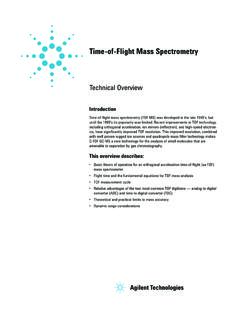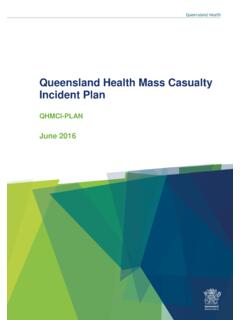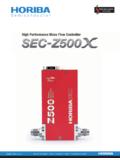Transcription of EXPERIMENT #1 PRECISION AND ACCURACY
1 1 SUNY OLD WESTBURY CHEMISTRY / PHYSICS DEPARTMENT PRINCIPLES OF CHEMISTRY EXPERIMENT #1: EVALUATION OF EXPERIMENTAL ERRORS BY PRECISION AND ACCURACY Objectives 1. To become familiar with different types of laboratory glassware 2. To learn how to evaluate experimental errors in terms of PRECISION and ACCURACY Guiding Questions Which is more precise and accurate, a 50-mL beaker or a 50-mLvolumetric flask? Support your answers with experimental data. When would you use glassware designed to contain a known volume, rather than glassware designed to deliver a known volume? When using glassware to measure a volume of liquid added or dispensed, must the glassware be dried before the measurement? Videos Basic Chemistry Lab Equipment PRECISION , ACCURACY , and Uncertainty in Chemistry Introduction During this chemistry lab, you will use various pieces of laboratory glassware, , beakers, Erlenmeyer flasks, volumetric flasks, transfer pipettes, micropipettes, burets and graduated cylinders.
2 All of the glassware listed above can measure volume. Why do we have so many pieces of glassware if they all do the same basic job of measuring volumes? Laboratory glassware can be divided into two types based on how they measure volumes. One is manufactured to contain certain volumes, so the volume of liquid in the glassware is well known. Another is made to deliver certain volumes; here the volume of liquid transferred is very well known. Before using any measuring device in the lab, we should determine how many significant figures the device allows. There is no such thing as a perfect measurement. Even when using expensive lab equipment there is some degree of uncertainty in measurement When using volumetric glassware, the general rule is that you can estimate one more digit past the smallest division on the measuring device. If you look at a 10-mL graduated cylinder, for example, the smallest graduation is a tenth of a milliliter ( mL).
3 That means when you read the volume, you can estimate to the hundredths place ( mL). The bottom of the meniscus is used to determine the volume in a 10-mL graduated cylinder (Figure 1). 2 Figure 1. Portion of a 10-mL graduated cylinder However, some glassware such as volumetric flasks and volumetric pipettes only have a single line to indicate volume. This is because they are made to measure just one specific volume. In our chemistry lab, both the 10-mL volumetric pipette and 50-mL volumetric flask are very precisely manufactured and have two significant figures after the decimal point ( mL and mL). A beaker is less precisely manufactured; a 50-mL beaker is assumed to have a maximum of 2 significant figures. You often need to combine laboratory measurements mathematically, such as subtracting the mass of an empty flask from a full flask to find the mass of liquid it contains. There are two simple calculation rules for significant figures.
4 For multiplication and division, the result will have the same number of significant figures as the number with the fewest significant figures. For addition and subtraction, the result will have the same number of digits to the right of the decimal point as the measurement with the fewest digits right of the decimal point. Two examples are given below: = and To help you record and analyze data, let s look at the measurements of the length of a single metal rod using three different measuring devices A, B and C. You may the obtain following experimental data and calculated results as shown in Table 1. The calculated values are explained beneath the Table. 3 Table 1. Measured Lengths of a metal rod using devices A, B, and C Device A Device B Device C Trial 1, cm Trial 2, cm Trial 3, cm Mean, cm , cm Relative 4% True Value, cm Error, cm Relative Error 16% 0% The mean (() from multiple trials can be calculated.)
5 A calculation example for Device A is given below: (= ()*)+,-= + + 123= cm = cm How do we describe how good this measuring device is? We can use PRECISION and ACCURACY . PRECISION is a measure of how close repeated measurements are to each other. The measurement from Device B has a higher degree of PRECISION than that from Device C because the values are clustered closely together. In statistics, PRECISION is evaluated by standard deviation ( ) and relative ( ). The can easily be calculated by using Excel, a web site such as , or a programmable calculator. Examples of manual calculations for Device A are given below: () (:*)+,- 1 ( ):+( ):+( ):3 1= 12 =>?@ABC> >@- 100%= 100%= 4 PRECISION is a measure of random error, and may reflect such things as careless technique, poor equipment, or natural variation in how individuals read scales. As indicated by the data in Table 1, the PRECISION in the measurements improves from the Devices C to B to A, as indicated by the increasing trend in the and for Devices C > B > A.
6 ACCURACY is a measure of how close the measured value is to the true value. To assess ACCURACY , you need to know the true or theoretical value from some source. If you are told the length of the metal rod is cm as a true value, you can determine the error (systematic error) and relative error. Examples are given below for Device A: Error = Experimental Value True Value = cm cm = cm The error can be positive or negative, depending on whether the experimental result is greater or less than the true value. =>?@ABC> GHHIH= GHHIHJHK> L@?K> 100%= 12 100%=16% Note that the relative error calculation uses the absolute value of the bias in the numerator, so it is always a positive number. ACCURACY is a measure of systematic error an error caused by something in the procedure or equipment that we may be able to correct. The most accurate measurement was obtained from Device C because bias = The lower the bias, the more accurate the measuring device.
7 Therefore, the ACCURACY increases in order of Devices C > B > A in terms of both systematic error and percent systematic error. Safety Glassware is fragile and needs to be handled with care. Hold glassware by the side and/or bottom rather than the top. Check glassware for any chips or cracks before using it and do not use cracked glassware. Inform the instructor immediately if any glassware is broken. Procedures You will measure the mass and volume of water using different types of volumetric glassware indicated in Table 2. You will then use the density of water to calculate the volumes delivered. The theoretical (true) volumes are obtained from the labels on the devices. The error for each volumetric tool can then be calculated. Three trials are required for each piece of glassware so that you can determine the PRECISION of your measurements. Table 2. Volumetric glassware Type of volumetric glassware Volume of de-ionized water (true value) 50-mL beaker mL 50-mL volumetric flask mL 5 1.
8 Obtain approximately 500 mL of de-ionized water in a 500-mL clean beaker. Place a thermometer in the water. Record the temperature after there is no change in temperature for at least ten minutes. This water will be used for all of the experiments 2. Record the density of water at this temperature in the unit of grams per milliliter using the density table attached at the end of this handout. 3. Obtain a 50-mL beaker listed Table 2. Ensure that it is dry and determine its empty mass using an analytical balance. Make sure all of the doors of the analytical balance are closed, as air currents in the lab can affect the balance. Record its mass in a data table (How many significant figures should you keep?). Remove the glassware from the balance. 4. From the 500-mL beaker, transfer 50 mL of water to the 50 mL beaker. Use a plastic disposable pipette to add the water drop-wise until the bottom of the meniscus is on the line that corresponds to the volume listed in Table 2.
9 If too much water was added, remove the extra water using the plastic disposable pipette. Wipe down the outside and bottom of the beaker in case any water was spilled during the transfer. 5. Using the same balance as before (why?), record the mass of the glassware with the added water. 6. Pour the water from the glassware back into the 500-mL beaker and repeat steps 4-5 two more times with the same beaker using the same balance. You can use the empty mass of beaker from step 3 for all three trials. 7. Repeat the process with other piece of glassware from Table 2. Do three trials for each volume. 8. Create data tables in your lab notebook to record the data and calculations as shown below. Device A: 50 mL Beaker Trial 1 Trial 2 Trial 3 mass of Empty beaker, g mass of Beaker + added H2O, g mass of H2O measured, g Volume of water measured = MNOO PQ RNSTU VT*O)SW PQ RNSTU, mL Mean measured volume from 3 trials, mL True volume, mL 50 +/- 5% , mL Error, mL Relative Error 6 Device B: 50 mL volumetric flask Trial 1 Trial 2 Trial 3 Empty flask, g Flask + added H2O, g mass of H2O measured , g Volume of water measured = MNOO PQ RNSTU VT*O)SW PQ RNSTU, mL Mean measured volume from 3 trials, mL True volume, mL +/- mL at 20 oC , mL Error, mL Relative Error Lab report and data analysis for each piece of glassware.
10 Use the experimental values to calculate volumes, means, and Use the averaged volume and the true value to calculate bias and relative bias. Be sure to show all calculations List the glassware in order of the highest to the lowest PRECISION and ACCURACY , respectively. Briefly describe the results you found and evaluate experimental errors in terms of PRECISION and ACCURACY . Materials and instruments needed for one group: 50-mL (1), and 500-mL (1) beaker 50-mL volumetric flask (1) Thermometer (1) Analytical balance (1) Dropper pipettes (several) Deionized water (500 mL) Paper towel or Kim Wipes 7 Density of water in g/mL vs. temperature at C (from CRC Handbook of Chemistry and Physics, 53rd Edition) 15 16 17 18 19 20 21 22 23 24 25 26 27 28 29 30 Instruction for using the density table above: to find the density of water at C, first go to the row in the left hand column at 20, then slide across that row to the column labeled with The density of water at C is g/mL.





